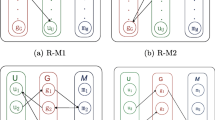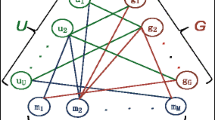Abstract
Social big data is currently an emergent issue, especially for recommender systems. In particular, with respect to social big data, various data mining techniques have been applied in group recommender systems. However, three social phenomena (i.e., social influence, emotional contagion, and conformity) have not been applied enough in existing studies. In this paper, a novel method for a group recommendation is proposed based upon the affective social network from social big data. In this regard, to explore and measure the social phenomena, a variety of similarity measures were applied in a content-based recommendation. Moreover, the proposed method has a computational complexity of O(N2), where N is the number of users in a group. Therefore, it is appropriate for big data environments, since the N is generally small for user groups. This study’s results revealed that the Mahalanobis distance was suitable for the affective group recommendation. Moreover, the proposed method outperformed the other group recommender systems, those with large groups.


Similar content being viewed by others
Notes
MyMovieHistory, https://ke.mymoviehistory.kr
References
Lee OJ, Jung JJ, You E (2015) Predictive clustering for performance stability in collaborative filtering techniques. In: Proceedings of the 2nd IEEE international conference on cybernetics, CYBCONF. Gdynia, Poland, pp 48–55
Gandomi A, Haider M (2015) Beyond the hype: big data concepts, methods, and analytics. Int J Inf Manag 35(2):137–144
Lee OJ, Hong MS, Jung JJ, Shin J, Kim P (2016) Adaptive collaborative filtering based on scalable clustering for big recommender systems. Acta Polytechnica Hungarica 13(2):179–194
Saranya KG, Sadasivam GS (2017) Personalized news article recommendation with novelty using collaborative filtering based rough set theory. Mobile Networks and Applications 22(4):719–729
Sánchez LQ, Recio-garcía JA, Díaz-Agudo B (2014) An architecture and functional description to integrate social behaviour knowledge into group recommender systems. Appl Intell 40(4):732–748
Piccialli F, Jung JE (2017) Understanding customer experience diffusion on social networking services by big data analytics. Mobile Networks and Applications 22(4):605–612
Sánchez L Q, Recio-garcía JA, Díaz-agudo B (2011) User satisfaction in long term group recommendations. In: Proceedings of the 19th international conference on case-based reasoning, ICCBR, vol 6880. Springer, London, Lecture Notes in Computer Science, pp 211–225
Piliponyte A, Ricci F, Koschwitz J (2013) Sequential music recommendations for groups by balancing user satisfaction. In: Proceedings of the 21st conference on user modeling, adaptation and personalization, Rome
Tommasel A, Corbellini A, Godoy D, Schiaffino SN (2015) Exploring the role of personality traits in followee recommendation. Online Inf Rev 39(6):812–830
Zhang Y (2016) Grorec: A, group-centric intelligent recommender system integrating social, mobile and big data technologies. IEEE Trans Serv Comput 9(5):786–795
Masthoff J, Gatt A (2006) In pursuit of satisfaction and the prevention of embarrassment: affective state in group recommender systems. User Model User-Adap Inter 16(3-4):281–319
Masthoff J (2011) Group recommender systems: Combining individual models. In: Recommender systems handbook, Springer, pp 677–702
Chen M, Mao S, Liu Y (2014) Big data: a survey. Mobile Networks and Applications 19(2):171–209
Wu X, Zhu X, Wu G, Ding W (2014) Data mining with big data. IEEE Trans Knowl Data Eng 26 (1):97–107
Orgaz GB, Jung JJ, Camacho D (2016) Social big data: recent achievements and new challenges. Information Fusion 28:45–59
Zhang Y, Tu Z, Wang Q (2017) Temporec: temporal-topic based recommender for social network services. Mobile Networks and Applications 22(6):1182–1191
Kompan M, Bieliková M (2014) Social structure and personality enhanced group recommendation. In: Proceedings of the 22nd conference on user modeling, adaptation and personalization, Aalborg
Hong M, Jung JJ, Piccialli F, Chianese A (2017) Social recommendation service for cultural heritage. Pers Ubiquit Comput 21(2):191–201
Kompan M, Bielikova M (2014) Group recommendations: Survey and perspectives. Computing and Informatics 33(2):446– 476
Tkalcic M, Chen L (2015) Personality and recommender systems. In: Recommender Systems Handbook, Springer, pp 715–739
Zheng Y, Mobasher B, Burke R (2017) Emotions in context-aware recommender systems. In: Emotions and personality in personalized services - models, evaluation and applications, Human-Computer Interaction Series, Springer, pp 311–326
Bond R (2005) Group size and conformity. Group Process Intergroup Relat 8(4):331–354
Han B, Rho S, Jun S, Hwang E (2010) Music emotion classification and context-based music recommendation. Multimedia Tools and Applications 47(3):433–460
Tkalcic M, Carolis BD, de Gemmis M, Odic A, Kosir A (2017) Introduction to emotions and personality in personalized systems. In: Emotions and personality in personalized services - models, evaluation and applications, Human-Computer Interaction Series, Springer, pp 3–11
Tkalcic M, Odic A, Kosir A, Tasic JF (2013) Affective labeling in a content-based recommender system for images. IEEE Trans Multimedia 15(2):391–400
Moshfeghi Y, Jose JM (2011) Role of emotional features in collaborative recommendation. In: Proceedings of the 33rd European conference on IR research, ECIR 2011, vol 6611. Springer, Dublin, Lecture Notes in Computer Science. pp 738–742
Chakraverty S, Mala S (2017) Review based emotion profiles for cross domain recommendation. Multimedia Tools and Applications 76(24):25827–25850
Chen Y, Pu P (2014) Designing emotion awareness interface for group recommender systems. In: Paolini P, Garzotto F (eds) Proceedings of the International Working Conference on Advanced Visual Interfaces, AVI 2014, ACM, Como, pp 347– 348
Chen Y, Ma X, Cerezo A, Pu P (2014) Empatheticons: Designing emotion awareness tools for group recommenders. In: Proceedings of the 14 international conference on human computer interaction, Interacción ’14, Puerto de la Cruz, Tenerife, Spain, September 10-12, 2014, ACM, pp 16:1–16:8
Guo J, Zhu Y, Li A, Wang Q, Han W (2016) A social influence approach for group user modeling in group recommendation systems. IEEE Intell Syst 31(5):40–48
Christensen IA, Schiaffino SN (2014) Social influence in group recommender systems. Online Inf Rev 38 (4):524–542
Christensen IA, Schiaffino SN, Armentano M (2016) Social group recommendation in the tourism domain. J Intell Inf Syst 47(2):209–231
Ekman P, Friesen WV, O’Sullivan M, Chan A, Diacoyanni-Tarlatzis I, Heider K, Krause R, LeCompte WA, Pitcairn T, Ricci-Bitti PE, Scherer K, Tomita M, Tzavaras A (1987) Universals and cultural differences in the judgments of facial expressions of emotion. J Pers Soc Psychol 53(4):712–717
Posner J, Russell JA, Peterson BS (2005) The circumplex model of affect: an integrative approach to affective neuroscience, cognitive development, and psychopathology. Dev Psychopathol 17(03):715–734
Yik M, Russell JA, Steiger JH (2011) A 12-point circumplex structure of core affect. Emotion 11(4):705
Hong M, Jung JJ (2016) Mymoviehistory: social recommender system by discovering social affinities among users. Cybern Syst 47(1-2):88–110
Piezon SL, Ferree WD (2008) Perceptions of social loafing in online learning groups: a study of public university and us naval war college students. The International Review of Research in Open and Distributed Learning 9(2):1034–1054
Stasser G, Davis JH (1981) Group decision making and social influence: a social interaction sequence model. Psychol Rev 88(6):523–551
Bond R, Smith PB (1996) Culture and conformity: a meta-analysis of studies using asch’s (1952b, 1956) line judgment task. Psychol Bull 119(1):111
Acknowledgements
This work was supported by the National Research Foundation of Korea (NRF) grant funded by the Korea government (MSIP) (NRF-2017R1A2B4010774).
Author information
Authors and Affiliations
Corresponding author
Rights and permissions
About this article
Cite this article
Hong, M., Jung, J.J. Towards Social Big Data-Based Affective Group Recommendation. Mobile Netw Appl 23, 1111–1122 (2018). https://doi.org/10.1007/s11036-018-1076-1
Published:
Issue Date:
DOI: https://doi.org/10.1007/s11036-018-1076-1




